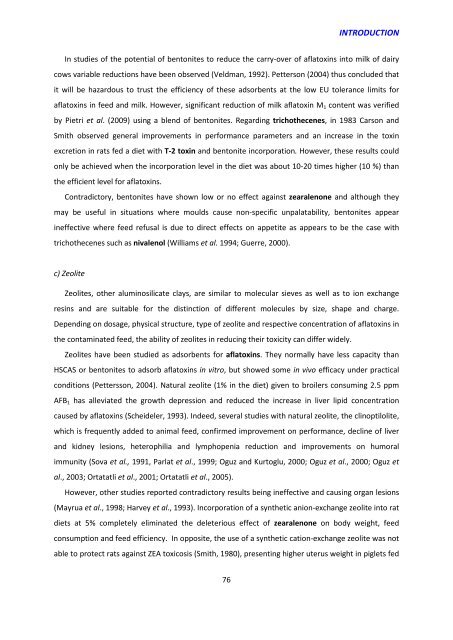Effet chez le porcelet d'une exposition à un régime co-contaminé en ...
Effet chez le porcelet d'une exposition à un régime co-contaminé en ...
Effet chez le porcelet d'une exposition à un régime co-contaminé en ...
Create successful ePaper yourself
Turn your PDF publications into a flip-book with our unique Google optimized e-Paper software.
INTRODUCTIONIn studies of the pot<strong>en</strong>tial of b<strong>en</strong>tonites to reduce the carry-over of aflatoxins into milk of dairy<strong>co</strong>ws variab<strong>le</strong> reductions have be<strong>en</strong> observed (Veldman, 1992). Petterson (2004) thus <strong>co</strong>ncluded thatit will be hazardous to trust the effici<strong>en</strong>cy of these adsorb<strong>en</strong>ts at the low EU to<strong>le</strong>rance limits foraflatoxins in feed and milk. However, significant reduction of milk aflatoxin M 1 <strong>co</strong>nt<strong>en</strong>t was verifiedby Pietri et al. (2009) using a b<strong>le</strong>nd of b<strong>en</strong>tonites. Regarding trichothec<strong>en</strong>es, in 1983 Carson andSmith observed g<strong>en</strong>eral improvem<strong>en</strong>ts in performance parameters and an increase in the toxinexcretion in rats fed a diet with T-2 toxin and b<strong>en</strong>tonite in<strong>co</strong>rporation. However, these results <strong>co</strong>uldonly be achieved wh<strong>en</strong> the in<strong>co</strong>rporation <strong>le</strong>vel in the diet was about 10-20 times higher (10%) thanthe effici<strong>en</strong>t <strong>le</strong>vel for aflatoxins.Contradictory, b<strong>en</strong>tonites have shown low or no effect against zeara<strong>le</strong>none and although theymay be useful in situations where moulds cause non-specific <strong>un</strong>palatability, b<strong>en</strong>tonites appearineffective where feed refusal is due to direct effects on appetite as appears to be the case withtrichothec<strong>en</strong>es such as niva<strong>le</strong>nol (Williams et al. 1994; Guerre, 2000).c) ZeoliteZeolites, other aluminosilicate clays, are similar to mo<strong>le</strong>cular sieves as well as to ion exchangeresins and are suitab<strong>le</strong> for the distinction of differ<strong>en</strong>t mo<strong>le</strong>cu<strong>le</strong>s by size, shape and charge.Dep<strong>en</strong>ding on dosage, physical structure, type of zeolite and respective <strong>co</strong>nc<strong>en</strong>tration of aflatoxins inthe <strong>co</strong>ntaminated feed, the ability of zeolites in reducing their toxicity can differ widely.Zeolites have be<strong>en</strong> studied as adsorb<strong>en</strong>ts for aflatoxins. They normally have <strong>le</strong>ss capacity thanHSCAS or b<strong>en</strong>tonites to adsorb aflatoxins in vitro, but showed some in vivo efficacy <strong>un</strong>der practical<strong>co</strong>nditions (Pettersson, 2004). Natural zeolite (1% in the diet) giv<strong>en</strong> to broi<strong>le</strong>rs <strong>co</strong>nsuming 2.5 ppmAFB 1 has al<strong>le</strong>viated the growth depression and reduced the increase in liver lipid <strong>co</strong>nc<strong>en</strong>trationcaused by aflatoxins (Scheide<strong>le</strong>r, 1993). Indeed, several studies with natural zeolite, the clinoptilolite,which is frequ<strong>en</strong>tly added to animal feed, <strong>co</strong>nfirmed improvem<strong>en</strong>t on performance, decline of liverand kidney <strong>le</strong>sions, heterophilia and lymphop<strong>en</strong>ia reduction and improvem<strong>en</strong>ts on humoralimm<strong>un</strong>ity (Sova et al., 1991, Parlat et al., 1999; Oguz and Kurtoglu, 2000; Oguz et al., 2000; Oguz etal., 2003; Ortatatli et al., 2001; Ortatatli et al., 2005).However, other studies reported <strong>co</strong>ntradictory results being ineffective and causing organ <strong>le</strong>sions(Mayrua et al., 1998; Harvey et al., 1993). In<strong>co</strong>rporation of a synthetic anion-exchange zeolite into ratdiets at 5% <strong>co</strong>mp<strong>le</strong>tely eliminated the de<strong>le</strong>terious effect of zeara<strong>le</strong>none on body weight, feed<strong>co</strong>nsumption and feed effici<strong>en</strong>cy. In opposite, the use of a synthetic cation-exchange zeolite was notab<strong>le</strong> to protect rats against ZEA toxi<strong>co</strong>sis (Smith, 1980), pres<strong>en</strong>ting higher uterus weight in pig<strong>le</strong>ts fed76

















